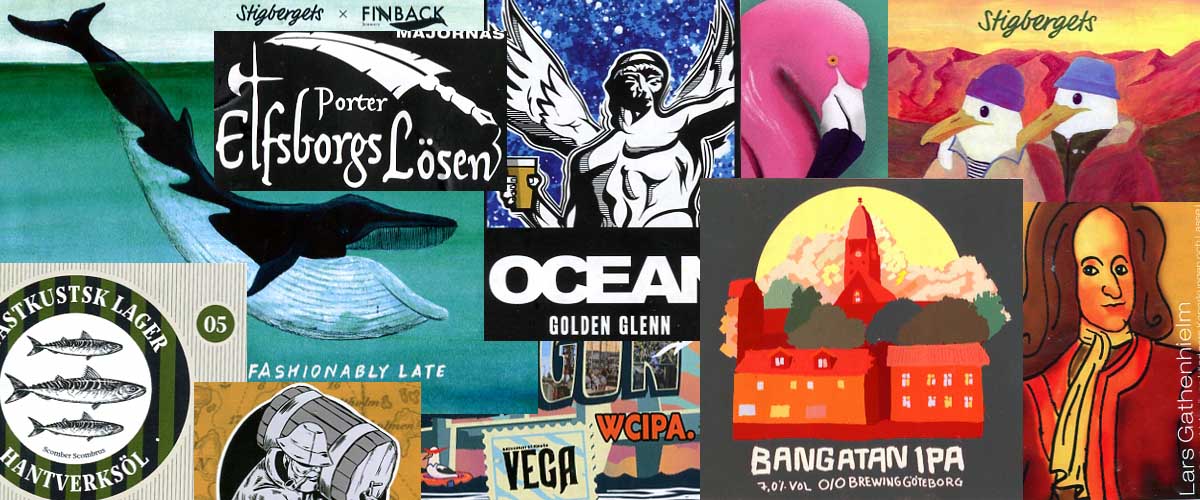Lately I’ve taken to buying beer by the label. Not in the sense that I am brand loyal and buy the labels I recognise, but in the sense of trying to collect different labels.
Label pleasures

Sometime last year I discovered that many smaller breweries, at least here in Sweden, are selling beer in cans with labels that are not directly printed on to the metal. I found you can, with a bit of patience, peel these labels off. They usually come off in one piece and retain their stickiness. The labels often feature artwork that is colourful and sometimes rather clever. I’ve been using them to brighten the pages of my Bullet Journal. (Bullet Journal decorating, as practised by some, feels like a supreme procrastination. Sticking beer can labels onto the journal pages is quick and easy and preserves a record.)
Long ago, I can remember sitting in pubs and idly peeling the labels off glass bottles. It’s hard to do that nowadays. I don’t know if it’s the glue they use or the paper (I suspect both). You can’t even soak them in water to remove the labels. But peeling the labels off cans works a treat.
The only drawback is that cans are sold here with a use-and-return premium. You have to leave the barcode on the can so that when you take them for recycling you can claim your refund. But cutting the bar code off and leaving it attached to the can, mostly, doesn’t affect the design. It just leaves a less than perfect edge.
So nowadays, when I visit the System* to stock up on beer, I spend a lot of time looking at the labels. Filling my shopping basket with colour and variety.
Beer revolution

I realise you might be thinking that this means one Swedish beer is much like another. If the only thing that differentiates them is their labels. But that’s not true. There’s been such a huge revolution in beer production and quality here in the last 20-odd years. Each of these beers is special, each has its own flavour.
I have my favourites, among the breweries and among the beers, but it’s a pleasure, every so often, to try new and different beers. You never know quite what you are going to be drinking. The descriptions on the labels and on the System shelves can’t convey the flavours and nuances. Not to me at any rate. So I buy depending on the artwork.
So much has changed in the last 20-odd years. When I first came to The North forty years ago (40 years!), beer was basically lager and nothing else. You could get something that was sold as porter. (It was a sort of dark, slightly bitter lager modelled on stout). At Christmas and Easter you might get a seasonal beer, which was often a bit darker and a bit sweeter, but basically it was also lager.
There was no beer culture and alcohol was so expensive that most people who drank seemed to drink themselves drunk at home before they went out.
Alco. %
The only distinctions between beers were the labelling and the alcohol by volume, which was printed prominently on the labels. (The “alco. %” is still on the labels, but it’s not as much a feature now as it used to be. It’s no longer a major selling point.)
Back then there were exactly four types of lager beer. To me they all tasted the same whether they came from a local brewery or from somewhere further off.
The beers were:
- No. 1 (low alcohol – less than 0.7% and usually 0.5%);
- No. 2 (“folk öl” – the people’s beer – 2.8%);
- No. 3 (3.5%, the strongest beer available in the supermarkets);
- and No. 4 (5.2% and up, but not very much up, which was only available in the System). No. 4 beer, if it wasn’t imported, tasted exactly the same as the supermarket beer. It was just stronger.
At that time British pub beer was hugely different. Britain had the reputation for being the home of good beer. (And as my Swedish friends assured me in tones of awe, the beer they sold was a whopping 4.2%!)
Back then I knew enough, when I was visiting the UK, to look to drink in pubs displaying a CAMRA sign – the Campaign for Real Ale. Otherwise I wasn’t so very impressed by British beer. It’s not British beer, not even CAMRA, that caused the beer revolution in Sweden. It’s the influence of the American brewing revolution.

Beer now
You still come across Swedes who buy beer for the alcohol content, but far more buy for flavour. Nowadays you can get all sorts of tasty beers here. Some with relatively low alcohol content, others very strong. Indian Pale Ale (IPA), American Pale Ale (APA), sour beer, Belgian style beer, wheat beer, corn beer, beer made with a very specific type of hops, a very specific type of yeast. The variety goes on. People are brewing at home. (My sister-in-law is a wizard.)
Looking back, the lager days seem very long ago. Nowadays the average British pub beer tastes even more insipid and watery.
Small breweries, producing short runs of craft beer, have to keep their outgoings down. It’s my guess that this is what has caused the surge in artful labelling. I suppose it’s cheaper for them to keep a generic stock of aluminium cans to fill, and print labels as necessary. Cheaper to pay an artist to design a new label for each session brew.
Given ongoing economic constraints and the coming of AI assisted design, I wonder how long the labels will continue to be interesting. But for the moment, after drinking a particularly nice beer, I’ll take my pleasure in peeling off the label and sticking it into my journal.











A digression on The System
For those unfamiliar with Sweden, The System – more correctly System Bolaget, the System Company – is the monopoly provider of strong alcoholic drinks in Sweden. You can’t buy anything with a stronger alcohol content than 3.5% by volume anywhere other than in a System shop, except in a restaurant with your food. (A proposed change in the law will allow farms and vineyards to sell their own brews and wines locally, but it hasn’t happened yet.) [^back)]




